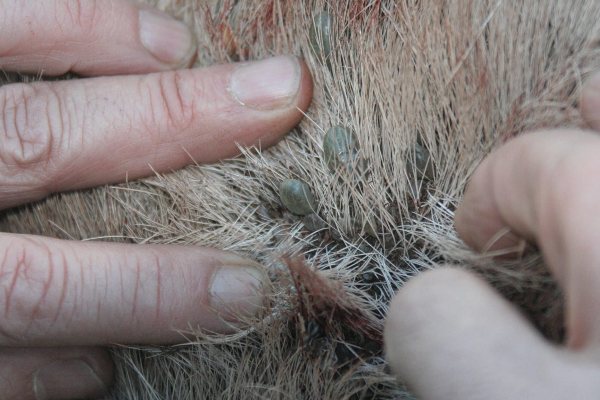Livestock, like all plot animals, are susceptible to external parasites such as ticks, lice and flies, and smallholders with livestock must be aware of these parasites and their dangers. While ticks can carry disease, even those without disease can be a problem. If nothing else, ticks are energy thieves, sapping the host’s vitality.
The host needs to replace the blood lost to ticks, as well as repair the damage done to the skin at the attachment site. Ticks find a host in three ways, depending on the species: some lay in wait on vegetation, attaching themselves to a host that walks by; some actively seek hosts by running over ground and some live in the nests or shelter of their hosts.
The tick has three phases in its life cycle: larvae hatch out of eggs, then later moult to nymphs. Nymphs feed once and moult in the same way as larvae. From the nymphal moult either a female or male adult emerges. The female feeds once and lays one huge batch of eggs. Eggs of all ticks are laid in the physical environment, never on the host. She then dies. The males may take several small feeds, mate and then die.
Types of Ticks
Amblyomma hebraeum ~ the bont tick are typically found in short pasture. (“Bont” is Afrikaans for “colourful”.) It is known as a bont tick because of its bright contrasting colours. Amblyomma hebraeum transmits Ehrlichia ruminantium (heartwater) to domestic and wild ruminants, Theileria mutans (benign bovine theilerioses) to cattle and Rickettsia africana, the cause of African tick-bite fever in humans. The larvae of A hebraeum are probably more responsible than any other tick for tick bites in humans.

Rhipicephalus decoloratus ~ African blue tick is most active in December to January and March to July. It can be widely dispersed on the host, although the adults prefer flanks and underbelly, while the immatures are found mostly on the ears, neck and dewlap. Rhipicephalus decoloratus transmits Babesia bigemina and Anaplasma marginale to cattle and Borrelia theileri, the cause of spirochaetosis, to cattle, sheep, goats and horses.
Rhipicephalus appendiculatus ~ Brown ear tick is a uniform brown colour and can be found on cattle, goats and horses. This tick is the main vector of Theileria parva, the causative organism of East Coast fever in cattle.
Rhipicephalus evertsi evertsi ~ the red legged tick is found throughout South Africa. Rhipicephalus evertsi evertsi transmits the causative organisms of equine piroplasmosi, ovine theileriosis and Babesia caballi to horses. It also transmits Anaplasma marginale, the causative organism of anaplasmosis in cattle.
Hyalomma rufipes ~ large, coarse bont-legged tick is drought and heat-tolerant. The long mouthparts cause tissue damage in cattle and sheep and secondary bacterial infections may lead to abscess formation. It can transmit Anaplasma marginale to cattle, causing bovine anaplasmosis or gallsickness and also Babesia occultans causing benign babesiosis in cattle; it can cause equine piroplasmosis in horses and donkeys; it can also transmit R conori to humans.
Diseases Carried By Ticks
Heartwater
Also known as Erlichiosis, it is a disease carried by the bont tick. The disease will be noticeable in sheep seven to 35 days after infection and nine to 29 days in cattle. Goats and game such as buffalo and antelope are also affected. Symptoms include foaming at the mouth, listlessness, high fever and loss of appetite. Infected animals start to make constant chewing movements, have difficulty breathing, and exhibit a high-stepping gait. Other symptoms include head pressing, lying down with the head pulled backwards and legs stretched out, and padding movements. Fluid builds up around the chest, belly, in the sac around the heart, the lungs, and windpipe of the infected animal. The disease is often fatal. Heartwater can occur throughout the year. The best treatment is prevention of infestation by ticks.
Redwater
Also known as Babesiosis, is another often fatal disease. There are two types: African and Asiatic. Ticks are infected when feeding on carrier or infected animals. The disease is transmitted from the larval stage to the nymph and adult tick. Redwater is carried by the blue tick and pantropical blue tick. African redwater disease symptoms become noticeable seven to 14 days after infection and include fever, anaemia, light- to darkbrown or red urine, poor appetite, weakness, dry nose, diarrhoea, dull coat, listlessness, unwillingness to move, abortion and, in advanced cases, jaundice. Asiatic Redwater symptoms occur nine to 14 days after infection and include fever and nervous system symptoms such as convulsion, loss of co-ordination, muscle tremors, and coma. Other symptoms include anaemia, listlessness, dry nose, and unwillingness to move, weakness, poor appetite, dull coat, abortion, diarrhoea and, in advanced cases, jaundice. Asiatic Redwater is common across Gauteng. Both African and Asiatic Redwater can lead to abortion or death shortly after birth and can also be fatal in adult animals.
Anaplasmosis
Another common tick-borne ailment, also known as Gallsickness, which occurs most frequently in the warmer months in Gauteng.


A most informative magazine which I wish I had known about 12 years ago when moving onto a small holding as topics would have helped me understand more into making a profitable income.